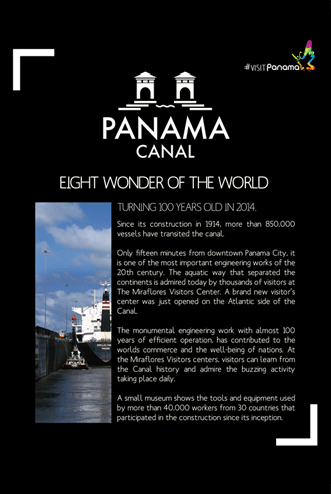

COUNTRY FACTS
COUNTRY FACTS
Panama, officially called the Republic of Panama, is a country usually considered to be entirely in North America or Central America. It is bordered by Costa Rica to the west, Colombia to the southeast, the Caribbean Sea to the north and the Pacific Ocean to the south. The capital and largest city is Panama City, whose metropolitan area is home to nearly half of the country's 4.1 million people.
Panama was inhabited by several indigenous tribes prior to settlement by the Spanish in the 16th century. Panama broke away from Spain in 1821 and joined a union of Nueva Granada, Ecuador, and Venezuela named the Republic of Gran Colombia. When Gran Colombia dissolved in 1831, Panama and Nueva Granada remained joined, eventually becoming the Republic of Colombia. With the backing of the United States, Panama seceded from Colombia in 1903, allowing the Panama Canal to be built by the U.S. Army Corps of Engineers between 1904 and 1914.
In 1977 an agreement was signed for the total transfer of the Canal from the United States to Panama by the end of the 20th century, which culminated on 31 December 1999.
Revenue from canal tolls continues to represent a significant portion of Panama's GDP, although commerce, banking, and tourism are major and growing sectors. In 2015 Panama ranked 60th in the world in terms of the Human Development Index.Since 2010, Panama remains the second most competitive economy in Latin America, according to the World Economic Forum's Global Competitiveness Index. Covering around 40 percent of its land area, Panama's jungles are home to an abundance of tropical plants and animals – some of them to be found nowhere else on the planet
PANAMA CANAL

The idea for a Panama canal dates back to the 1513 discovery of the isthmus by Vasco Núñez de Balboa. The narrow land bridge between North and South America houses the Panama Canal, a water passage between the Atlantic and Pacific Oceans. The earliest Central American European colonists recognized this potential, and several proposals for such a canal were made.
By the late nineteenth century, technological advances and commercial pressure allowed construction to begin in earnest. An initial attempt by France to build a sea-level canal failed after a great deal of excavation. This enabled the United States to complete the present canal in 1913 and open it to shipping the following year. The state of Panama was created with its 1903 emancipation from Colombia due to a US-backed revolt, so the US could control the canal-project area.
French canal engineer Philippe-Jean Bunau-Varilla influenced a change in its proposed location, from Nicaragua to Panama because of his concern about Nicaraguan volcanism. During the late 1890s Bunaua-Varilla convinced US lawmakers to buy the rights to build the French canal in Panama, sending each senator Nicaragua postage stamps with a smoking volcano. In 1903, Colombia refused to allow the United States to build the canal. The people of Panama, with help from Bunaua-Varilla, then overthrew their Colombian government and became independent.
The Panama Canal continues to be a viable commercial venture and a vital link in world shipping. The 2007 Panama Canal expansion project began commercial operation on 26 June 2016. The new locks allow transit of larger Post-Panamax and New Panamax ships, which have a greater cargo capacity than the original locks could accommodate.
 HOME >
HOME >
